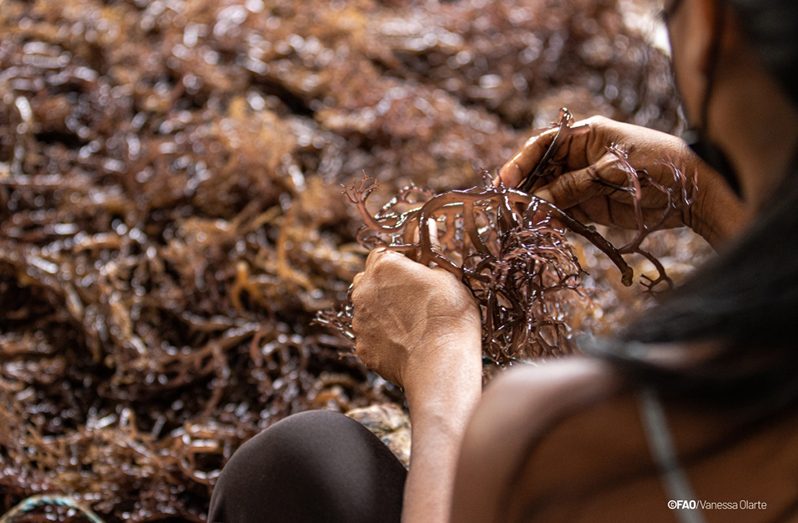(FAO) ON the edge of the Caribbean Sea is an autonomous, Indigenous Peoples’ territory in Panama which has been inhabited by the Guna people for centuries. It winds its way around the gulf of the same name and includes an archipelago of around 300 islands. Within this territory is Naranjo Grande, a coastal town where the sea represents food, work and life itself.
This is where Luisa Lopez Hurtado has lived all her life. A member of the Guna Indigenous People, she has fished with her family off of Panama’s eastern coast for as long as she can remember.
“I grew up by the sea,” says Luisa, a mother of four sons. “When I was young, I accompanied my father on his fishing trips.”
For generations the Guna people have relied on marine and coastal resources for their lives and livelihoods. But Luisa, who heads the Naranjo Grande women’s association, says it’s becoming harder for fishers to make a living as local stocks of fish and lobster have been impacted by overfishing and climate change.
“Fish production is different from when I was a child. There is not as much fish as there used to be, and it is increasingly difficult to find lobsters, which were plentiful in the past,” she says.
Maria Dickson, a 24-year-old member of Luisa’s women’s group, confirms this. “Production has decreased drastically,” Maria says. “Sometimes I think they catch them too small and that is why they can’t reproduce.”
Women play a significant role in the Guna community with many engaged in cleaning and processing fish, as well as working in agriculture, tourism and handicraft production. But they are often dependent on men for their income.
The drastic fall in tourism since the start of the COVID-19 pandemic combined with declining fish stocks have had a devastating impact, pushing many families, especially women-led households, into poverty.
The FAO is now opening new opportunities for the Guna people by sharing skills related to algae production and processing. A new training initiative for coastal Indigenous fishers, particularly women, gives them livelihood options from a different source.
Backed by the Panamanian Administration of Aquatic Resources (ARAP) and the territory’s Indigenous government, the FAO pilot programme works with 20 women and five men sharing knowledge on how to grow, harvest and process marine algae before transforming it into commercial soaps and creams.
Alejandro Flores, FAO’s senior regional fisheries and aquaculture officer for Latin America and the Caribbean, says it is about increasing the resilience and independence of Guna women.
“We were looking to work with an Indigenous women’s organization to contribute to their economic empowerment,” says Flores.
After consultations with the Naranjo Grande association, FAO and ARAP approached Gracilarias de Panama, a private firm that specialises in the sustainable cultivation and export of marine algae. The company agreed to train the group on a probono basis and to buy their products.
While Gracilarias helped build the capacity of the Guna women in cultivating marine algae, FAO worked with the women on the creation and administration of a rotational fund and helped them organise a cooperative for selling their produce.
Participants planted the initial green algae in November 2021 and the first harvest took place in February 2022. They sundried the algae and learned how to extract agar, a jelly-like substance, from the walls of the algae to make soaps and cosmetics.
Flores says eventually the intention of the fund, set up from the profits of these economic activities, is to finance other projects and support families during emergencies.
“It’s in the early days, but they have made important progress,” says Flores. “They’ve already harvested twice. They feel a lot more empowered now and have contributed more to their families so they can be more autonomous.”
Maria says she’s already thrilled with the new skills she has learned. “I never imagined that algae could be cultivated; that was a surprise,” she says.
“I can’t wait for us to be able to make products and sell them locally and to tourists. That will be a great help to our economy, and I am sure there will be positive changes in the community.”
Gracilarias regards the initiative as a success and a model not only for communities of women in Panama but for the entire region.
Apart from those who participated, another 150 members of the Guna community hope to take part in the project in the future.
Beyond the production of soaps and creams, Gracilarias says it hopes to eventually work with the Guna Indigenous women on the commercialisation of dried seaweed and using seaweed planting areas as ecotourism centres to cater to local and foreign visitors.
The project coincides with the International Year of Artisanal Fisheries and Aquaculture (IYAFA 2022) which highlights the critical role of small-scale fishers and fish workers and their contribution to lives and livelihoods.
By recognising the value of the work of small-scale artisanal fishers, fish farmers and fish workers, FAO is looking to create a world where they are empowered to enhance their contribution to human well-being, healthy food systems and poverty eradication through the responsible and sustainable use of marine and natural resources.
Algae offers Indigenous fishers new prospects in Panama
SHARE THIS ARTICLE :
Facebook
Twitter
WhatsApp



.jpg)











